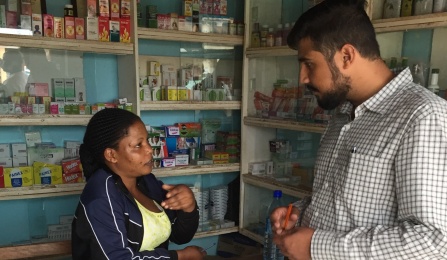Last Mile: A Matter of Life and Death
 Access to essential medicines is not only about the development and cost of pharmaceuticals but also supply chain logistics. The "last mile" plays a particularly important (and challenging) role in low- and middle-income countries, such as Uganda. Industrial and systems engineering research reveals major disparities in access to essential medicines.
Access to essential medicines is not only about the development and cost of pharmaceuticals but also supply chain logistics. The "last mile" plays a particularly important (and challenging) role in low- and middle-income countries, such as Uganda. Industrial and systems engineering research reveals major disparities in access to essential medicines.
In the United States, we are used to looking at fully stocked shelves at pharmacies. The “last mile” of a pharmaceutical supply chain is the last step transaction when drugs change hands from a pharmacist to a patient. Worst case scenario, a patient will wait a few hours to pick up their prescription. However, in many low-income counties, this scenario is utopian. A patient may walk hours to the pharmacy before being turned away due to unavailability of drugs. Resulting effects include illnesses that go untreated for long periods of time, infections that turn resistant, poor management of chronic illnesses, and even death. Pharmaceutical supply chains, or the process of moving goods from manufacturer to the patient, are complex in low-income countries.
 Industrial and Systems Engineering student Biplab Bhattacharya testing a survey tool with a drug shop owner in UgandaSourcing of ingredients and manufacturing drugs have become easier with technological advances. This has led to the growth in the pharmaceutical industry in most developed and developing countries. However, low-income countries depend on donor funding and importing drugs to satisfy the needs of the people who live in those areas. These two dependencies in combination lead to a complex supply chain. Donor funding face challenges of adequacy and timeliness. Importing drugs open opportunities for inefficiencies because of the drugs having to change several hands before reaching the patient. A layer of complexity is added by features like inefficient and unstable transportation systems, infrastructure, storage systems and security which are inherent to a low-income country.
Industrial and Systems Engineering student Biplab Bhattacharya testing a survey tool with a drug shop owner in UgandaSourcing of ingredients and manufacturing drugs have become easier with technological advances. This has led to the growth in the pharmaceutical industry in most developed and developing countries. However, low-income countries depend on donor funding and importing drugs to satisfy the needs of the people who live in those areas. These two dependencies in combination lead to a complex supply chain. Donor funding face challenges of adequacy and timeliness. Importing drugs open opportunities for inefficiencies because of the drugs having to change several hands before reaching the patient. A layer of complexity is added by features like inefficient and unstable transportation systems, infrastructure, storage systems and security which are inherent to a low-income country.
Some preliminary findings below further motivate the need to research and interventions to reduce drug stock-outs in low-income countries:
- The mortality rate of children under 5 is 69% with Pneumonia, Malaria and Diarrhea being the top three contributors. All of the above are treatable with over the counter pharmaceuticals available at drug stores.
- Malaria accounts for 50% of the country’s morbidity and mortality. In some districts, only 50% of public health facilities were found to have regular supplies of ACTs, and many were vulnerable to stock-outs between deliveries. In some districts, as few as 4% of private sector outlets stocked ACTs.
- Stock-outs of essential medicines are higher in Uganda than all other pharmaceuticals as per a nationally representative survey. 14% of facilities were stocked out of Amoxicillin, that is used to treat Pneumonia [1]
- Artemisinin-based combination treatments and metformin were the most commonly found medicines in the private medicine outlets surveyed. Ninty-nine percent of all outlets carried artemisinin-based combinations while 93% of pharmacies and 53% of drug shops stocked metformin. Oxytocin was found in one third of outlets surveyed. Fluoxetine was in 70% of pharmacies yet was not found in any drug shops. Rifampicin and lamivudine were found infrequently in outlets across all districts; 10% and 2%, respectively. Not all brands found in surveyed outlets were listed on the Ugandan National Drug Register. In particular, five unlisted brands of rifampicin were found in private medicine outlets [2]
The Community for Global Health Equity is facilitating the development of a partnership between faculty-led project teams from the department of Industrial and Systems Engineering and the Clinton Health Access Initiative, Uganda. The collaboration is working towards understanding inventory management behaviors of medicine outlets in Uganda to help tailor pharmaceutical supply chain interventions by incorporating for local practices and behaviors.
1. Masters, S.H., et al., Pharmaceutical availability across levels of care: evidence from facility surveys in Ghana, Kenya, and Uganda. PloS one, 2014. 9(12): p. e114762.
2. Birabwa, C., et al., The availability of six tracer medicines in private medicine outlets in Uganda. Journal of pharmaceutical policy and practice, 2014. 7(1): p. 18.
- Tags:
- Amoxicillin
- Artemisinin-based combination
- chronic illnesses
- Clinton Health Access Initiative
- collaboration
- Community for Global Health Equity
- cost of pharmaceuticals
- Department of Industrial and Systems Engineering
- development of pharmaceuticals
- diarrhea
- drug resistance
- fluoxetine
- healthcare access
- inventory management behaviors
- lamivudine
- low-income counties
- malaria
- Oxytocin
- pharmaceutical supply chain interventions
- pneumonia
- public health
- rifampicin
- supply chain logistics
- Uganda
- Ugandan National Drug Register
- University at Buffalo
- Login to post comments